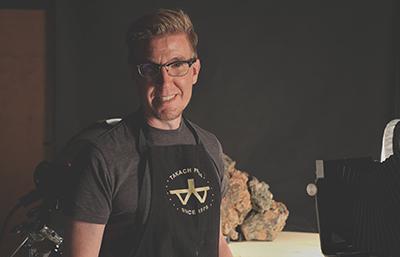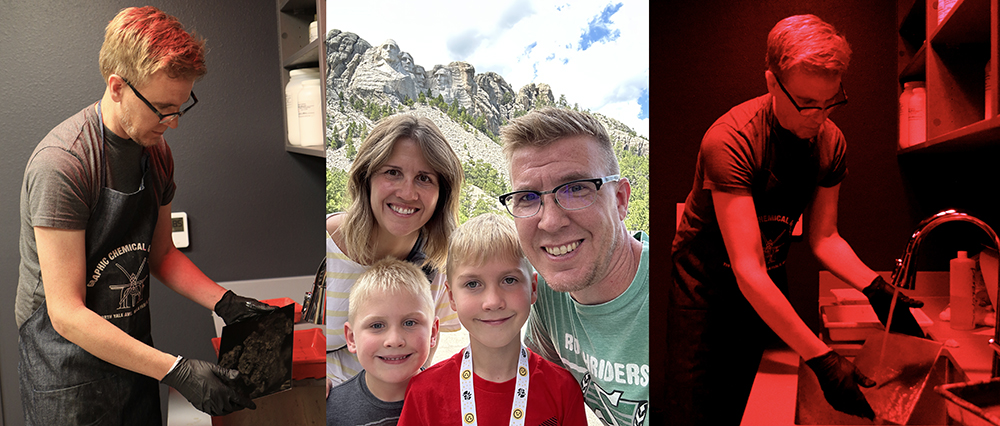Onward: An interview with Ryan Stander

MINOT, N.D. – Ryan Stander isn’t afraid of the dark — at least if there is a red light on.
Stander, an associate professor of fine art at Minot State, spends a lot of his time in the darkroom at Minot State as a professor and as an artist. The Alton, Iowa native earned the 2015 Artist Fellowship from the North Dakota Council of the Arts and the 2014 President’s Vision 2013 Merit Award from Minot State.
Minot State’s University Communications spent a few minutes in the darkroom and the photo lab with Stander to learn more about one of MSU’s most creative professors.
You teach in the art department; tell us about what are some of the classes you teach.
My specialty is photography, and so I teach all levels of photography at MSU including digital, smartphone, traditional film, alternative processes, and advanced. In those courses, we cover three eras of photography: historic chemistry-based, modern film, and contemporary digital. I also get to teach a paperworks course that covers handmade books, letterpress, and paper making.
We know you make incredible prints; what are some of your image-making techniques?
My creative work settles primarily within photography and printmaking and covers a pretty wide range that includes digital, film, and alternative process photography. I also love working the polyester plate litho process and letterpress. But first and foremost, my work is rooted in the photographic image. Having a diverse set of practices allows me to make a lot of different kinds of work. Right now, I am working on series of tintype self-portraits about trauma, illness, and recovery.

What were some of the reasons you chose to come to MSU?
MSU impressed me with its active faculty, student work, and commitment. I enjoyed the sense of community in the department and university.
Do you have a favorite moment or a couple of favorite moments, events, etc., from your time at Minot State?
Oh…so many! From NOTSTOCK and Flat Tail Press visiting artists, to working with student researchers on grant projects, working with David Driesbach and his family to bring his print collection to MSU, and seeing students succeed and present amazing capstone projects after working for many months.
What are some of the reasons you chose to teach art?
That’s a long story, but essentially, I love working shoulder-to-shoulder with students, helping them refine and achieve their creative visions. I love seeing them grow as artists, think in new ways, and take a process or idea and make it their own.
Were you artistic growing up? What are some of the things you did early on and do you have or keep any of those early works?
My first love was drawing. I was the youngest of six kids and saw my siblings come home with drawings and paintings from high school which inspired me. As a child, I saw my father use this beautiful Voigtlander camera he bought while stationed in Germany, and my brother use a Canon SLR. These men inspired me to get my first camera, a Kodak Disc camera when I was in 6th grade and I started recording my little world. I held on to the prints I made from that camera, and then about 20 years ago, I started scanning and incorporating them into my work.
Who were your inspirations in the art world as you were growing up and then as you progressed through your career?
Again, there are so many! Besides my siblings when I was young, I had two distinct inspirations: a game and a book. My mom had an oversized soft-cover book of “100 Great Paintings.” I remember sitting in her bedroom carefully turning the pages to study each painting. My family also owned a game about buying and selling art called Masterpiece which used many great paintings from the collection at the Art Institute of Chicago. Together, they formed my first art history lessons. In high school, I discovered Andy Warhol, and in college, Robert Rauschenberg, who still greatly influences my printmaking. In college, I found the work of photographers like Henri Cartier-Bresson, Robert Doisneau, Brassai, and Walker Evans filter into my work. As my art awareness grew, so did the number of artists I tracked, like Stephen Shore and the New Topographics, William Eggleston, Saul Leiter, Sally Mann, Gordon Parks, and so many more.

Being an artist doesn’t necessarily require studying it or earning a major in it; what is your philosophy on why students should study art?
It doesn’t… There are so many resources out there for people who might want to grow in their creative interests. However, studying art in a college or university offers some distinct advantages. Studying art in a university setting will expose you to many new ideas, artists, and processes that you probably wouldn’t find on your own or be able to afford. Art departments provide a community of like-minded people to challenge, inspire, and encourage each other. Lastly, studying art in a university develops your awareness to many other areas that can inform and relate to your artwork. Art connects beautifully to the sciences, history, marketing, social media, and communications as wonderful conceptual conversation partners. For non-art majors, the arts provide a means of developing their creative skills and lifelong interests and offer a means of personal expression.
You both teach and make art, how does doing each help you become better at the other?
Several years ago, I had an exhibition called Learning Curve in which I showed almost all of my first wet plate collodion images (a beautiful but temperamental photo process invented in 1851) including the many failures. I wanted to show off that learning never stops, even for faculty. As an artist, you must always be learning which puts you in the position of the student. The show, and really learning, is about failure and finding creative ways to move past failure. As I said in the show, failure is not fatal but the necessary way forward. My failures help me when students fail and vice-versa. We learn together and from one another.
What do you like to do outside of the classroom: family, hobbies, or other areas of interest?
I am husband to Karina and father to Willem and Mathis. Hobbies include reading, woodworking, and restoring our lovely mid-century modern home.
What else are we missing in telling your story?
I have advanced degrees in two distinct fields: art (BA in art from Northwestern College, Iowa, and MFA in mixed media from the University of North Dakota) and theology (MA in Bible and theology, Kairos University). Yet for me and my creative work, they are not distinct but go hand-in-hand. The two fields almost always come into some dynamic conversation as I make art or write theology. When I am doing one, I find myself thinking about the other.
About Minot State University
Minot State University is a public university dedicated to excellence in education, scholarship, and community engagement achieved through
rigorous academic experiences, active learning environments, commitment to public service, and a vibrant campus life.
Published: 06/13/24


